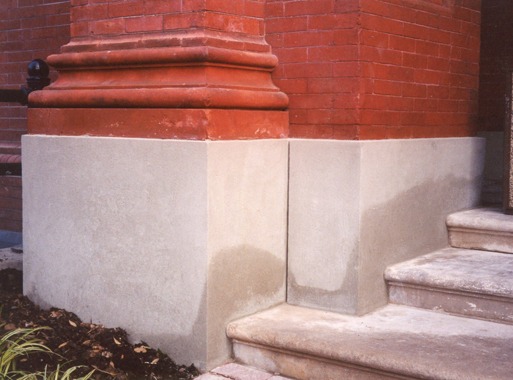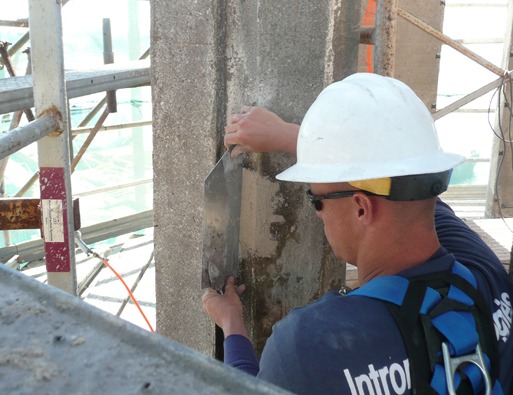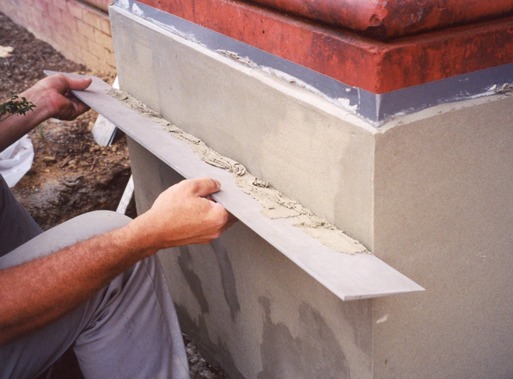Patching: Extending the life of masonry
Words: Dan Kamys
Patching
 Shown is a final patching repair, just after completion.
Shown is a final patching repair, just after completion.
By Steve Fechino
Patching of masonry materials during a new construction project is typically a line item that was not planned during the estimating phase of the project. Understanding the products commonly available for patching, capabilities, compatibility and limits of each product will enable you to make better choices when selecting the products required for each patching condition.
Masonry restoration contractors typically are experts in the field of patching as a major portion of their business can be repairing historic structures with deteriorated stone, concrete and terra cotta. The patching of stone on a building under construction may have several steps that are different from patching an existing masonry restoration project. This is due to color matching, stone preparation, pre-patch cleaning and moisture content of the substrate.
Though products have different characteristics and uses, the substrate in all cases must be free of loose and damaged material, greases, bituminous coatings, plant growth, paints and sealers. Proper preparation of the base material will ensure the best possible bond for the patching material.
Not every chip should be patched. Many patches, no matter how well they are installed, will draw the eye to the patch and not to the overall appearance of the elevation. Many chips are too shallow and feathered, which will cause many patching compounds not to perform well. A shallow patch can be applied in mandatory situations. However, they must be cut at the perimeter of the patch to create an edge, along with increasing the depth of the patch to meet the minimum depth requirement for the material that you choose.
 Aligning final patch with the substrate
Aligning final patch with the substrate
Akemi
Some products commonly used by stone masons have several different uses, depending on the repair or installation. Akemi has been used for years to secure anchors, set Dutchman pins and “glue” in patches. Mixing stone dust into akemi can enhance the color of the epoxy, allowing for less obvious patch. Akemi for exterior use must be labeled as exterior-grade material and mixed with an activator to create the proper composition for the mason. Akemi can be sanded, polished and honed, offering many options for small patches. There are akemi products on the market that have good ultra violet resistance, but they are, by no means, the standard. When patching fine-grained granites and marbles, akemi can be a great choice for repairs, with pre-planned color matching, short curing times and fine consistency.
Akemi can be used in a wide range of temperatures and will cure below freezing when an accelerator is used. On the opposite end of the thermometer, an accelerator is not recommended for situations over 85 degrees Fahrenheit.

Stone patching
Jahn Restoration Mortars are single component restoration patching mortars that are mixed with water and applied drier than block mortar to create a durable, carvable and color-matched repair. This patching material can be used on a variety of substrates with predictable results. Competing with traditional patching materials that typically combine three materials – water, latex modifiers and base mixture – to create a patching material, this product eliminates the opportunity for mixing errors.
Jahn Restoration Mortars do not use latex or acrylic bonding agents in the creation of the repair, eliminating failure due to salt and freeze-thaw cycles. The process for Cathedral Stone Products to choose the proper restoration mortar begins with analyzing the substrate. Once the substrate composition has been determined, a mix is chosen from hundreds of mixes that are on file. By matching the mix to the substrate, the repair weathers and performs at a higher level than standard repair. The material is placed on surfaces that are sound. The product can be placed in any thickness, due to a unique formulation that does not exhibit shrinkage. This creates a different approach to the labor installing the product. In pointing applications, single lift installations are not a problem.
When creating a repair, remove all small chips and damaged substrate mortar before application. Presoaking the substrate is not required for the Jahn Restoration Mortars products and is not recommended, as the addition of water can affect the final color of a repair. Something that Cathedral Stone Products takes great pride in is matching from original substrate samples sent to their lab. Intermittent misting of the lifts and finished patches is recommended for a period of 72 hours, to allow proper hydration and curing of the repair. When misting is impossible, applying polyurethane sheathing and encasing the repair – securing available moisture – will offer another way to cure a repair that, otherwise, would present curing problems.
Latex modifiers
Latex modifiers are not simply the “milk” we add to mortar. Latex modifiers offer many different compounds with many different properties to the mortars that they enhance.
A few of the compounds commonly found and labeled as latex modifiers are carboxylated styrene butadiene latex emulsion and unique reactive acrylic additives. The bottom line is that latex modifiers improve mechanical performance, workability, resistance to the elements, and – most important – adhesion.
Latex modifiers are not for every patch application, but they do have a place in the market. Currently, the cultured stone industry has mandated that all mortars shall be latex modified – a plus for the applicators in this industry.
Mortar
Typically, masonry mortar is not a good choice for patching many types of masonry. Sure, it will hold for a little while, but as a long-term patching material, the properties of mortar will not perform well. The addition of latex modifiers will help it to “stick” to the substrate, but it is recommended that, if you are considering using masonry mortar as a patch, do not use it for a structural patch or a decorative patch. The labor will not be worth the long-term results.
 Creating an even final surface of the repair
Creating an even final surface of the repair
Concrete patching
Concrete patching can be as simple as rubbing slurry over pock holes or parging concrete into a large chip. This type of patching is not the intent of this article, as the focus is on products formulated especially for specific concrete repairs.
Sika manufacturers a single-component patching material that uses latex modifiers and, typically, has an early strength characteristic that makes workability and bond superior to standard mortars. These patching mortars can be used on precast, some cast stone products and many terra cottas found in the industry. With the ability to handle above- and below-grade applications, these products allow for many opportunities for a quick repair when least expected. Patching mortars can be water permeable, and it is suggested that the product manufacturer be contacted after curing for recommendations on whether to use a water repellant.
Preparation of all patches requires that the substrate be of sound material. Roughing up of the surface will increase surface bonding area and offer courser material to which the patch can bond.
Concrete patches in both new construction and historic restoration can have steel reinforcement. In the past, many anchors were found to be of common steel. Terra cotta failures are largely occurring, due to the steel support system of pipes and wires that exhibit corrosion and displacement. When setting anchors for any of the mentioned products, it is important that the anchors be set in a substrate that exhibits integrity, with the ability to hold the additional eccentric loading of the patch. Hot-dipped galvanizing and stainless steel anchors are the most commonly used products in construction.
When setting dowels for a patch, the contractor should consider using threaded rod with embedment equal to one-half the length of the exposed dowel. It also is recommended to place a one-inch bend at 45 degrees on the end of the exposed portion of the dowel, for better holding abilities of patching materials as well as increasing the length of the dowel in shallower patches. It is important to note that pilot holes drilled to hold the dowels must be no more than 1/16-inch greater in diameter of the dowel. Epoxies used to set the dowels must be chosen based on the substrate to which the dowels are attaching.
Latex modifiers typically are used when applying the Sika patch to the base stone, just prior to applying the patching material.
Bonstone
Bonstone offers a patch compound that has ultra violet stability and is intended for interior and exterior aesthetic repairs to limestone, sandstone, concrete and various masonry applications. The patching material is suitable for mitered corners, coarse grained stones, foot traffic on stairs and walkways, and some decorative applications.
Bonstone’s patching material is water absorptive – a positive factor when patching a masonry restoration project in which residual moisture exists. An absorptive patch also will allow moisture to exit through the patch, which is a positive feature when repairing older structures.
Application of the patch material can be performed successfully below freezing, but there’s no reason to patch anything under these conditions, since frozen moisture within the substrate can pose problems for the contractor. This product can be color matched for a more professional surface patch appearance.
sfechino@mortarnet.com.
Return to Table of Content